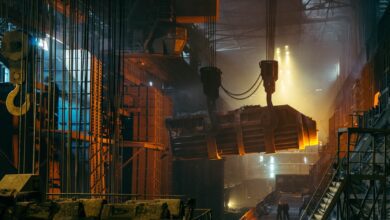Metallurgy Unveiled: Exploring Metals, Sustainability, and Future Trends in the Industry

Metallurgy is more than just the study of metals; it is a vital science that underpins various industries, from construction to aerospace. As we navigate through an increasingly technology-driven world, understanding metallurgy becomes essential for both economic and environmental sustainability. This article delves into the fascinating realm of metallurgy, beginning with a foundational overview of its principles and applications in industrial settings. We will explore the diverse types of metals, including ferrous and non-ferrous metals, precious metals like gold and silver, and rare earth metals that play critical roles in modern technology. As we look to the future, we will discuss the importance of sustainable metal production, innovative recycling methods, and emerging trends in metal commodities, including battery metals essential for energy solutions. Whether you're interested in metal fabrication, metal mining, or investing in precious metals, this exploration of metallurgy will provide insights into how these materials shape our lives and the industries that drive our economy. Join us as we uncover the rich tapestry of metallurgy and its impact on our world today and tomorrow.
- 1. Understanding Metallurgy: The Foundation of Metal Science and Its Applications in Industry
- 2. Exploring Metal Types: From Ferrous and Non-Ferrous Metals to Precious and Rare Earth Metals
- 3. The Future of Metallurgy: Sustainable Production, Recycling, and Emerging Metal Trends
1. Understanding Metallurgy: The Foundation of Metal Science and Its Applications in Industry
Metallurgy is a vital scientific discipline that focuses on the study and manipulation of metals, encompassing their extraction, refining, and fabrication processes. This foundational science plays a crucial role in various industries, providing the necessary knowledge to develop and utilize both industrial and precious metals effectively. Understanding metallurgy allows for the production of high-quality metal alloys, which combine different base metals to enhance their properties and performance.
In the realm of metal mining, metallurgy begins with the extraction of raw materials, such as ferrous metals like steel and non-ferrous metals including aluminum, copper, and zinc. The refining processes involved in metallurgy ensure that these metals meet the required specifications for their intended applications, thus driving advancements in sectors like construction, automotive, aerospace, and energy.
As industries increasingly prioritize sustainable metal production, metallurgy has adapted to incorporate more environmentally friendly practices, including metal recycling. This approach not only minimizes waste but also reduces the demand for raw materials, thereby promoting a circular economy. The rise of metal recycling is particularly significant for precious metals like gold and silver, as well as rare earth metals essential for modern technologies.
Furthermore, the exploration of metal trends within metallurgy has led to innovative applications, such as 3D printing metals, which revolutionize manufacturing processes. These advancements enable the creation of complex geometries and lightweight components, particularly in aerospace and automotive sectors, where performance and efficiency are paramount.
The understanding of metal corrosion is another critical aspect of metallurgy. By studying how different metals react to environmental factors, metallurgists can develop protective measures to extend the lifespan of metal products. This knowledge is especially relevant for construction metals and energy metals that face harsh conditions.
Investing in metals, including battery metals like lithium and precious metals like platinum and palladium, has also gained prominence as global markets evolve. This trend highlights the importance of metallurgy in shaping the future of both technology and finance.
In summary, metallurgy serves as the foundation of metal science, impacting diverse applications across industries. Its principles guide the effective use of various metals, from base metals to precious and rare earth metals, ensuring that the world continues to innovate and progress in a sustainable manner.
2. Exploring Metal Types: From Ferrous and Non-Ferrous Metals to Precious and Rare Earth Metals
Metallurgy encompasses a wide range of metal types, each with unique properties and applications. Understanding these variations is crucial for industries ranging from construction to aerospace.
Ferrous metals, primarily composed of iron, are known for their strength and durability. Common examples include steel and cast iron. These metals are widely used in construction and automotive manufacturing due to their ability to withstand heavy loads and resist wear. However, ferrous metals are prone to corrosion, which can impact their lifespan.
On the other hand, non-ferrous metals, such as aluminum, copper, zinc, and precious metals like gold and silver, do not contain iron. These metals are valued for their resistance to corrosion and lightweight properties, making them ideal for various applications including jewelry, electrical wiring, and aerospace components. Precious metals, particularly gold and silver, are also popular in investment markets, making them sought-after metal commodities for gold investing and silver investing.
Rare earth metals, which include elements like lithium and platinum, are crucial for modern technology. These metals play a vital role in the production of batteries, electronics, and renewable energy systems. Their rarity and the complex processes involved in metal mining contribute to their high market value.
In addition to these, base metals such as copper and aluminum are essential in metal fabrication and construction. They are widely used in infrastructure projects and are key components in various metal alloys, which enhance strength and resistance to corrosion.
Sustainable metal production is becoming increasingly important, as industries seek to minimize environmental impact. This includes metal recycling initiatives that recover valuable materials from scrap and waste, thereby reducing the need for new metal mining.
Emerging trends in metallurgy also highlight the rise of 3D printing metals, which allow for innovative designs and greater customization in manufacturing. As industries continue to evolve, understanding the diverse categories of metals will be essential for staying ahead in the competitive landscape of metallurgy.
By exploring the properties and applications of ferrous, non-ferrous, precious, and rare earth metals, industries can make informed choices that enhance their production processes and product offerings while also considering sustainability and metal trends.
3. The Future of Metallurgy: Sustainable Production, Recycling, and Emerging Metal Trends
The future of metallurgy is poised for significant transformation, driven by the need for sustainable production, innovative recycling methods, and the emergence of new metal trends. As industries increasingly prioritize environmental responsibility, sustainable metal production is becoming a focal point. This shift requires the development of techniques that minimize waste and reduce energy consumption while producing high-quality metals.
Metal recycling plays a crucial role in this transition, offering an effective solution for reducing the demand for virgin materials. By recycling industrial metals such as steel, aluminum, copper, and zinc, we not only conserve resources but also lower the carbon footprint associated with metal mining. The recycling of precious metals like gold and silver is particularly important in sectors such as jewelry and electronics, where the demand for these materials remains high.
Emerging trends in metallurgy also spotlight the significance of rare earth metals and battery metals, which are essential for modern technologies, including renewable energy systems and electric vehicles. As the automotive and aerospace industries evolve, the demand for lightweight yet durable materials has surged, leading to increased interest in metal alloys that combine strength and efficiency. Furthermore, advancements in 3D printing metals are revolutionizing metal fabrication, allowing for the creation of complex components with less waste and enhanced customization.
Investors are also taking note of the shifting landscape, with gold investing and silver investing gaining traction as individuals seek stable assets in uncertain times. The metal commodities market is seeing fluctuations driven by geopolitical factors and the growing interest in sustainable practices.
As we look ahead, the metallurgical sector must continue to adapt, embracing innovations that enhance the longevity of metals while addressing challenges such as metal corrosion and the efficient use of refractory metals. The integration of sustainable practices will not only benefit the environment but also ensure the ongoing viability of metallurgy in various applications, from construction metals to energy metals. The future of metallurgy is bright, filled with opportunities for growth, sustainability, and technological advancement.
In conclusion, metallurgy stands at the forefront of contemporary material science, playing a crucial role in various industries ranging from construction to aerospace. As we have explored, understanding the different types of metals—whether ferrous or non-ferrous, base or precious—enables us to leverage their unique properties for innovative applications. The future of metallurgy is increasingly intertwined with sustainability, emphasizing the importance of metal recycling and the responsible sourcing of rare earth metals. As we advance towards sustainable metal production practices, the potential for new metal trends, such as 3D printing metals, will likely revolutionize the way we approach metal fabrication and design.
Investing in metals, including gold and silver, remains a compelling opportunity, especially as the demand for energy metals like lithium and palladium rises in response to technological advancements. Furthermore, the exploration of refractory metals and the continued development of metal alloys will enhance our capabilities in combating metal corrosion and improving the performance of industrial metals. Ultimately, the field of metallurgy not only shapes our current industry practices but also paves the way for innovative solutions that meet the challenges of tomorrow. As we embrace these changes, the significance of metallurgy in our daily lives and its impact on various sectors will continue to grow, ensuring that we remain at the cutting edge of metal commodities and production techniques.
References:
[Include all relevant sources here]




